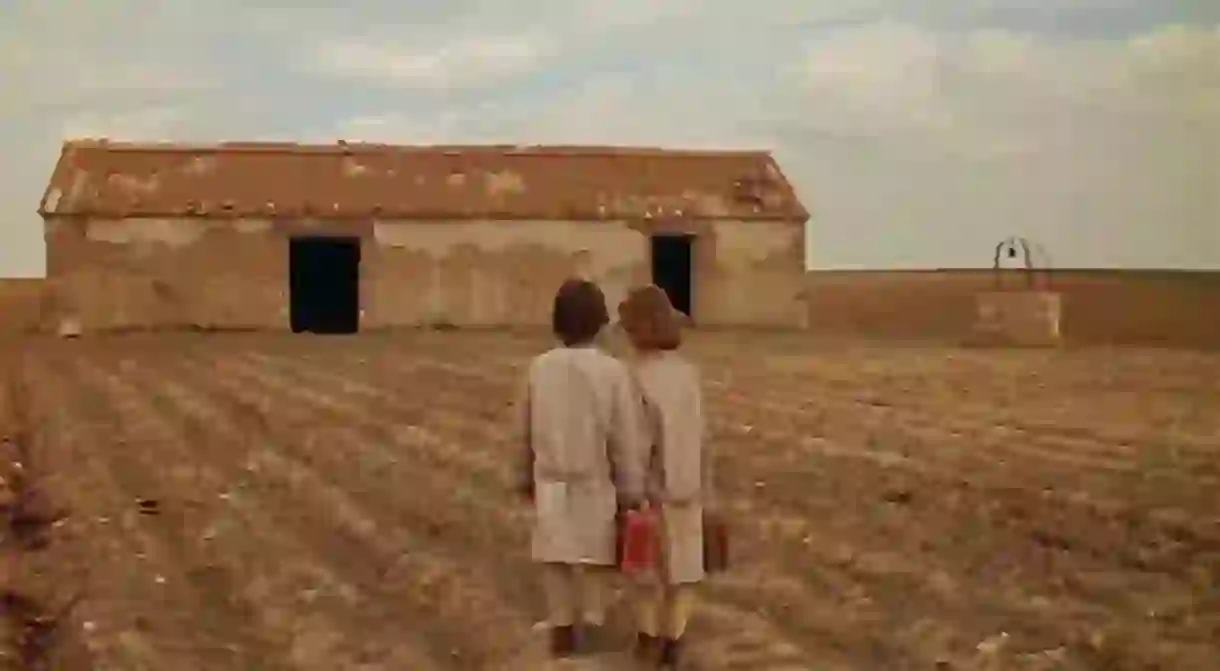Outdoor Cinema at Socrates Sculpture Park Screens a Haunting Spanish Masterpiece

Victor Erice’s The Spirit of the Beehive is an inspired choice for al fresco cinema, but think twice about bringing little kids…
This year marks the 20th anniversary of Outdoor Cinema at Socrates Sculpture Park in Long Island City, Queens. Curated by the programmers at Film Forum and Rooftop Films, the Wednesday evening screenings of international films run from July 11 through August 29.
The choice of film for August 8 is ideal for an outdoor, communal screening, as Victor Erice’s The Spirit of the Beehive (1973) opens with a community coming together in front of a makeshift cinema screen. The people of a tiny village on the vast Castilian plain attend a town-hall screening of James Whale’s Frankenstein (1931), brought to them by the cinema truck that visits monthly.

Written by Erice, Ángel Fernández Santos, and Francisco J. Querejeta, The Spirit of the Beehive, set in 1940, was filmed elliptically and doesn’t disclose all it secrets. Franco was 34 years into his 36-year military dictatorship when the film came out: It conveys the sense of fear and resignation that the Spanish people had lived with for nearly four decades.
Among the rapt audience for Whale’s Gothic horror classic are two sisters, six-year-old Ana (Ana Torrent) and the slightly older Isabel (Isabel Tellería), who live with their parents, Teresa (Teresa Gimpera) and Fernando (Fernando Fernán Gómez), in the local manor house. Ana is disturbed by the scene in which Frankenstein’s Monster (Boris Karloff) accidentally murders the little girl he befriends.

Isabel explains to her that the Monster is a spirit in human form, and that neither he nor the little girl died, since movies are fake. Nonetheless, Ana believes something real has taken place and her imagination integrates the dreadful spectacle into her daily reality. Isabel, who has an older child’s habit of playing on a younger sibling’s fears, at one point feigns her own death to terrify Ana.
These girls are left far too much to their own devices. They place their ears to the rails of the nearby track to listen for coming trains, then stand just feet from the track when the trains thunder past. Fernando is preoccupied with the random, chaotic behavior of his bees and writes deep into the night about his probably fruitless invention of a glass hive. On one occasion when he comes to bed, Teresa feigns sleep so he won’t disturb her. A distant wife and mother, she writes clandestine letters to a former lover who is held in a post-Spanish Civil War Red Cross camp in France.

Out on the plain stands a disused sheepfold that the girls explore. It is the Monster’s house, Isabel tells Ana. Soon Ana takes to going there alone. She may not have a death wish exactly, but her desire to see the Monster is influenced by the knowledge that he has killed a little girl on screen. When a wounded Republican fighter takes refuge there, she brings him food and drink. Like the escaped convict whom the children believe is Jesus in Whistle Down the Wind (1961), the Republican means something imperceptible to Ana, though it would be simplistic to suggest she thinks he is the Monster. His affect on her is nonetheless calamitous.
Teresa and Fernando live amicably enough—she covers his shoulders with a shawl when he falls asleep at his desk at night—but they are also entrapped by their marriage and social circumstances. One clue to this is the honeycomb-patterned, honey-colored leaded windows of their mansion, which holds them like Fernando’s hives hold their bees, and which, he says, are domiciles of feverish, senseless activity.

Bees, like the Spanish people, are victims in this context. Yet the bees in an indoor tube made of a thin wire mesh, which Ana blows and fingers dangerously, would impose a threat should they get loose. Though Erice’s symbolism is complex, it’s evident that the beehive of the film’s title is Spain under Franco.
Ana’s imagination militates against entrapment, but like the imagination of a subversive artist grappling with a monster in Franco’s Spain, it is imperiling. It eventually brings on a trauma that echoes the national trauma of the late war and Francoism.
Whether you watch it indoors or out, The Spirit of the Beehive is a haunting film—once seen, never forgotten. Every adult who, as a child, stepped out of bounds and tempted fate, will identify with little Ana—and perhaps with Ana Torrent, the now middle-aged actress, who is unable to shake the experience of playing the little girl.
This much is made clear by Torrent’s participation in a Spanish documentary about the making of the movie that appears among the extras on the Criterion Collection DVD of the film. It shows Torrent returning to Ana’s family’s house in the village many years later. Didn’t she know you should never go back?
The Summer 2018 Socrates Social Park Outdoor Cinema screenings begin at sundown. Pre-screening performances begin at 7pm. Admission is free. This is the lineup of films:
July 11: Monsoon Wedding (India)
July 18: Black Mother (USA/Jamaica)
July 25: The Young Girls of Rochefort (France)
August 1: Loveling (Brazil)
August 8: The Spirit of the Beehive (Spain)
August 15: Tampopo (Japan)
August 22: Kedi (Turkey)
August 29: The Passionate Thief (Italy)













